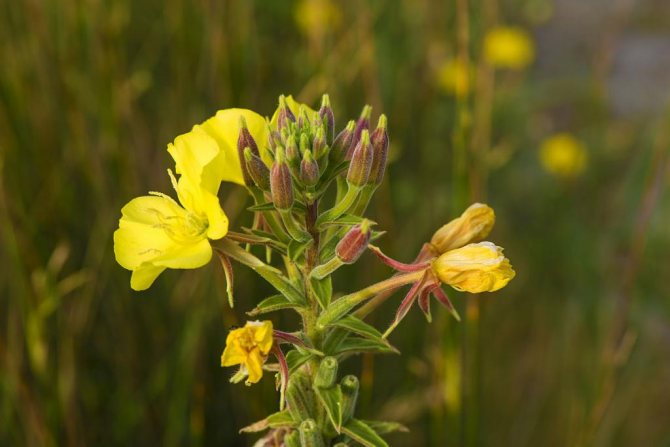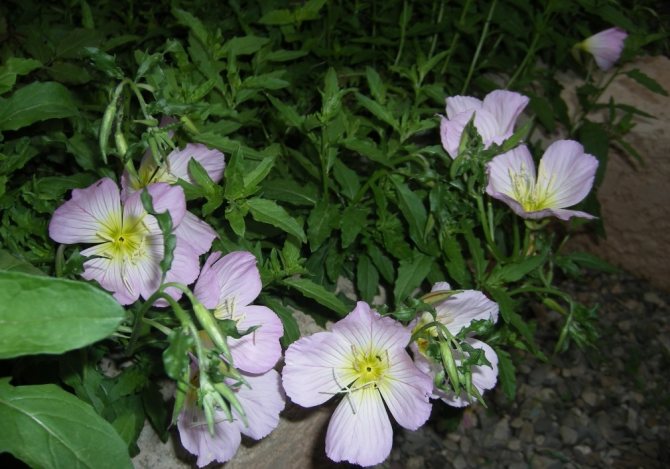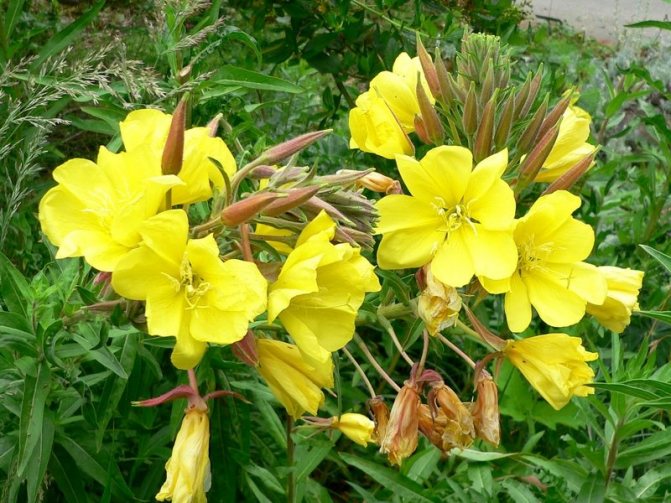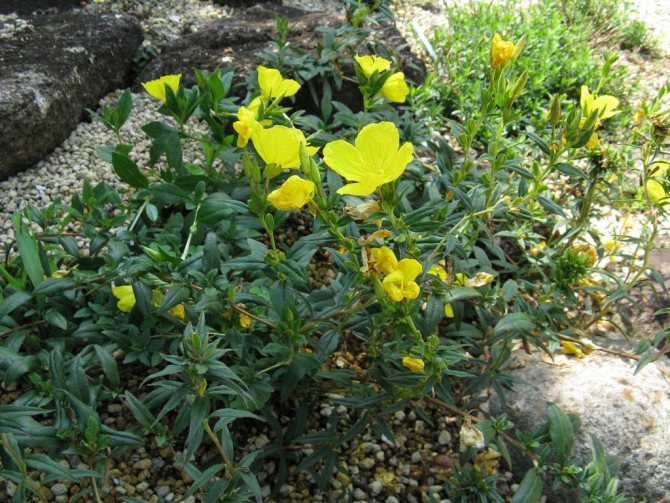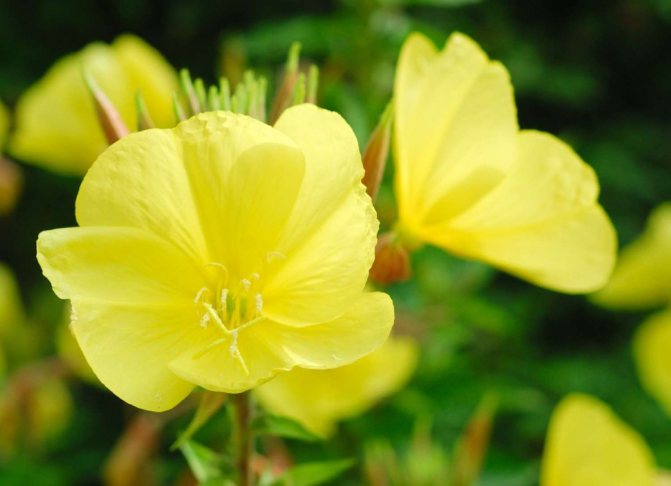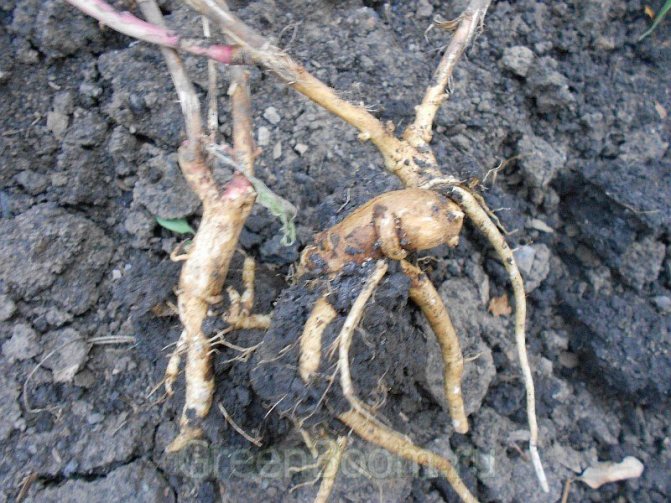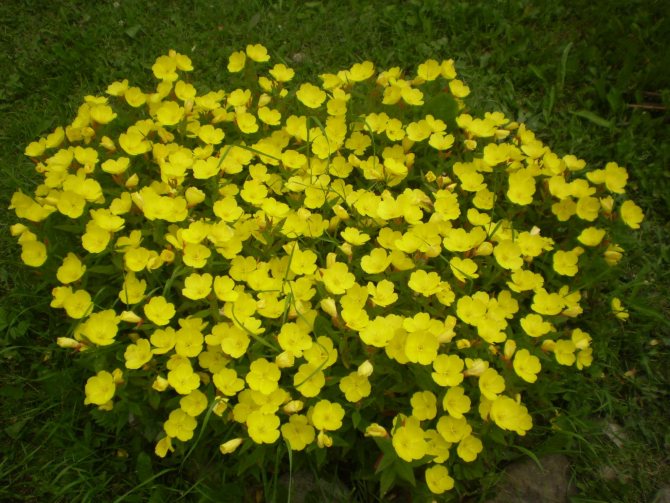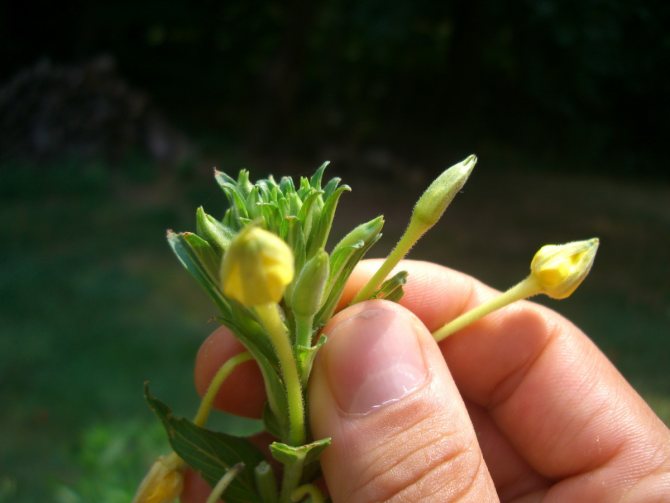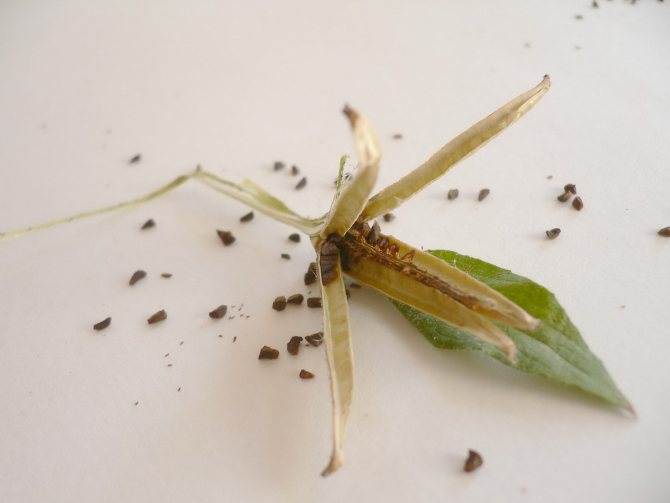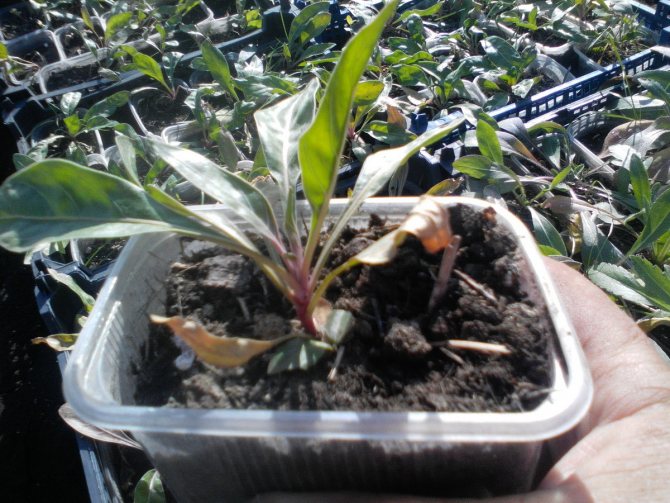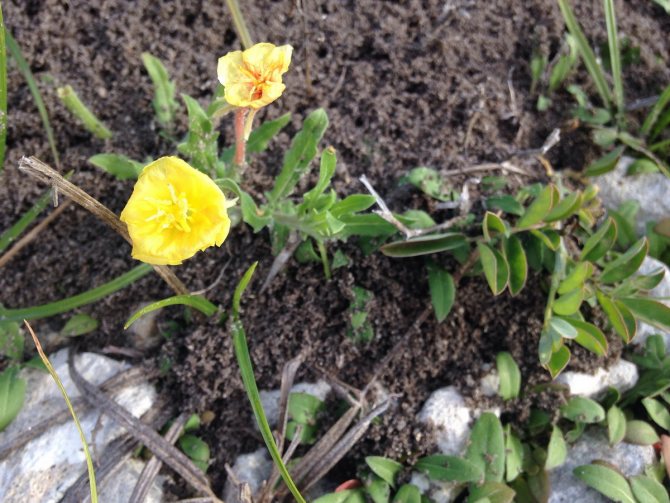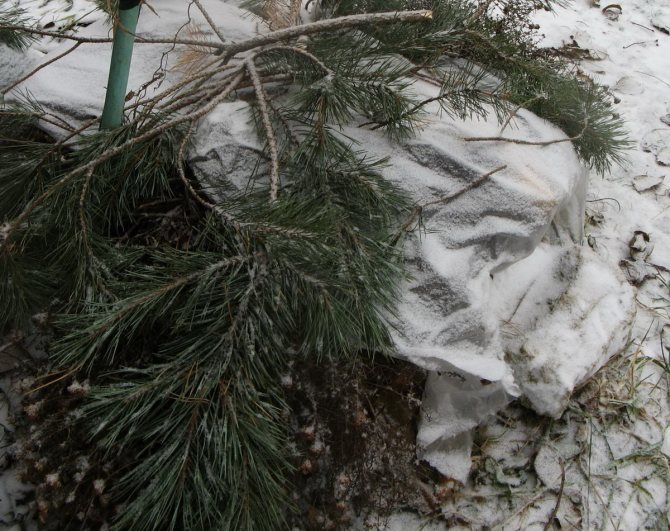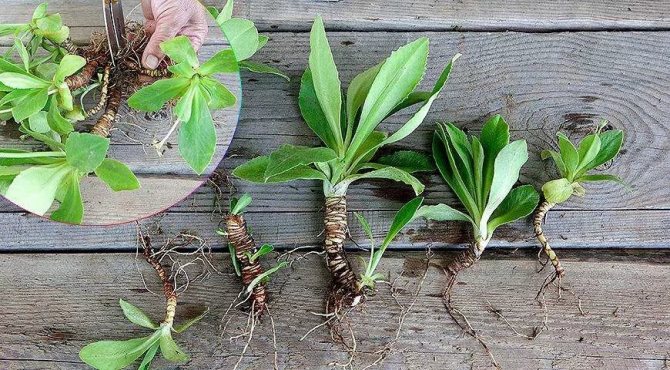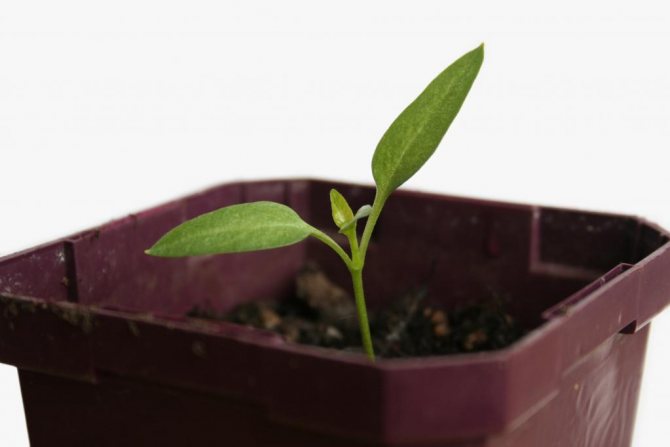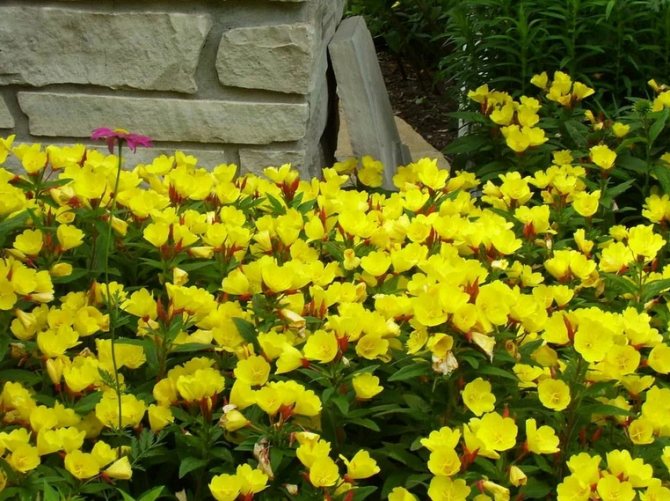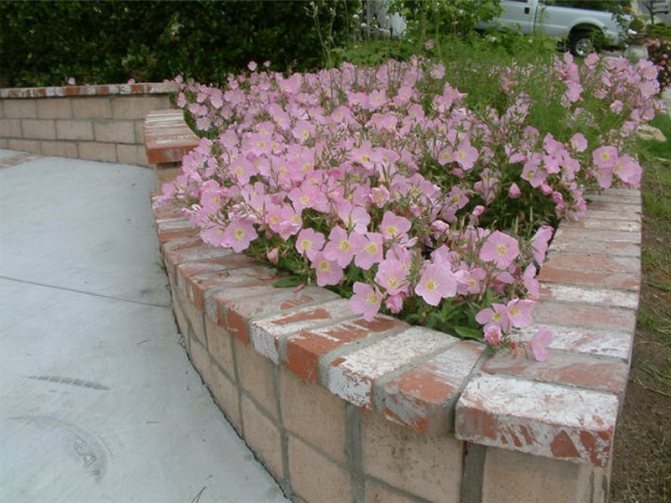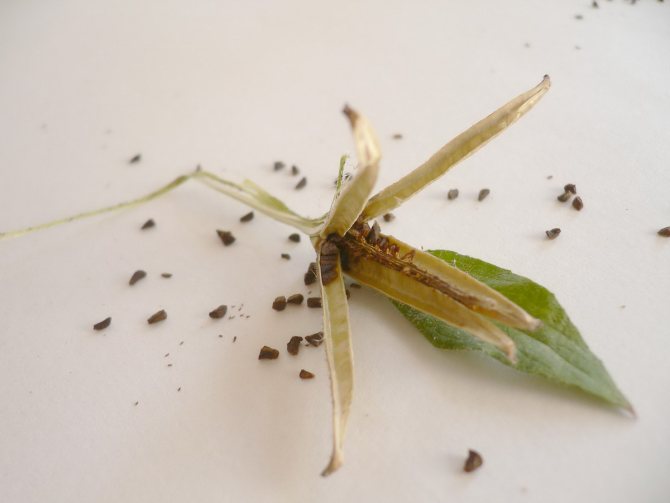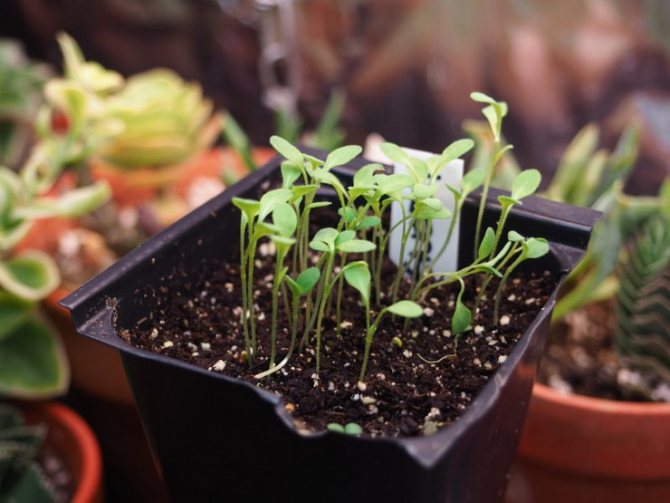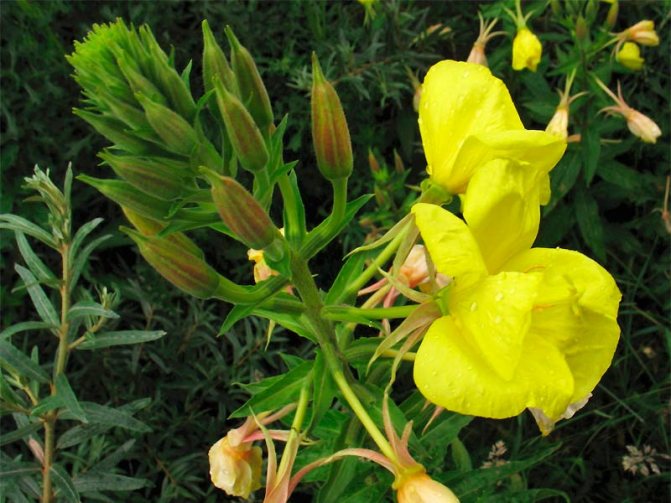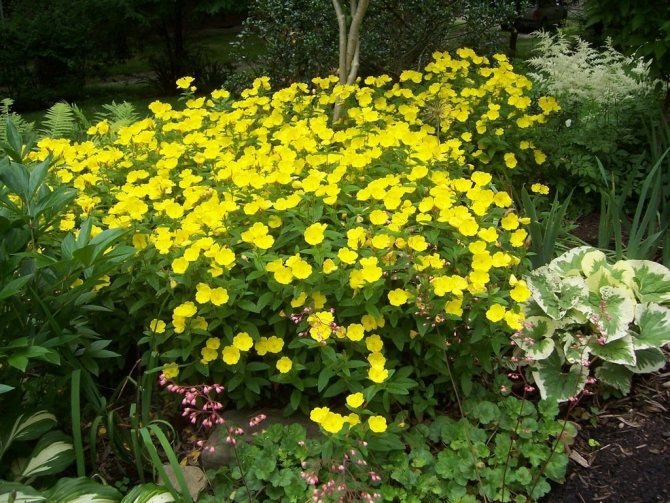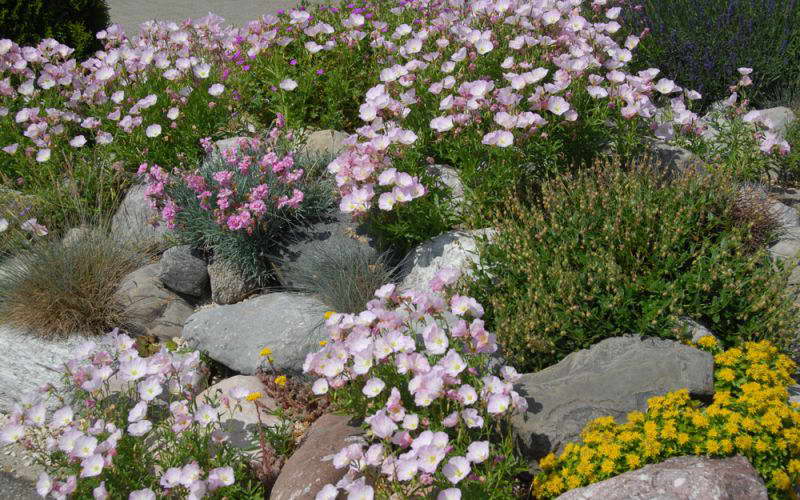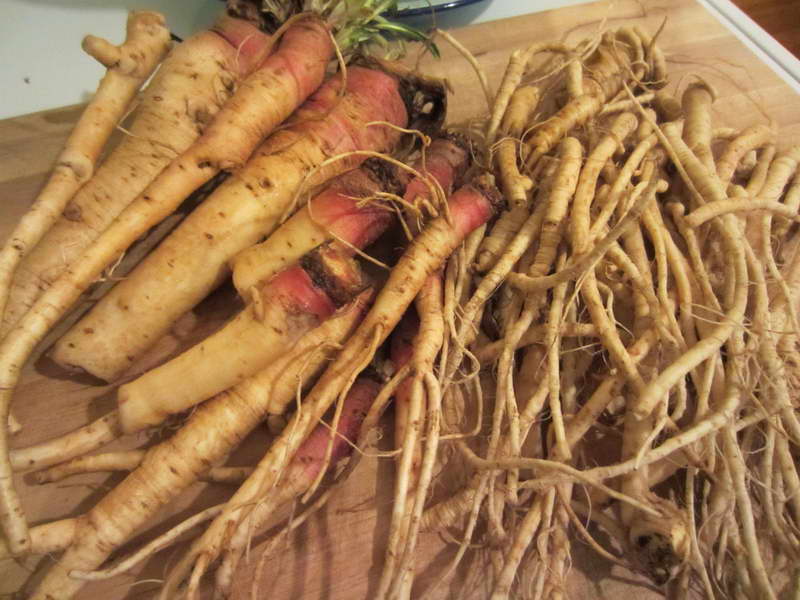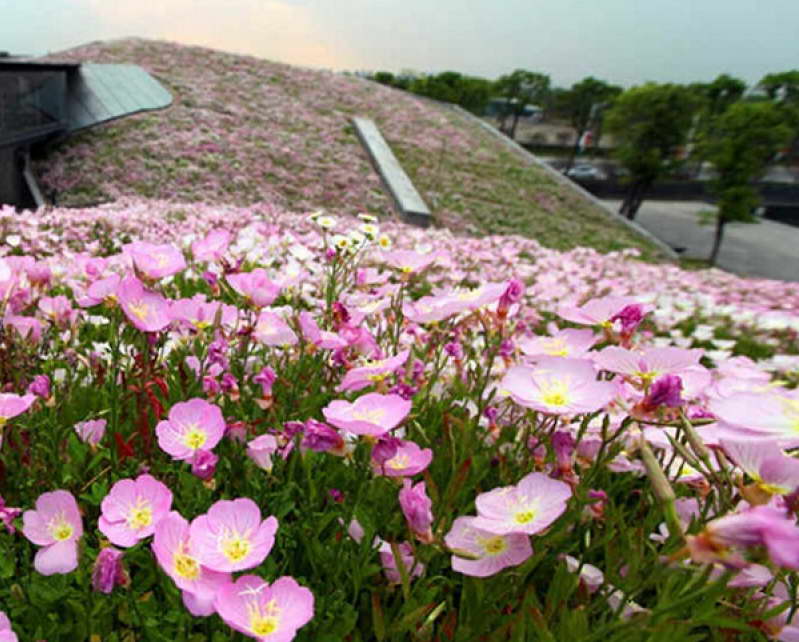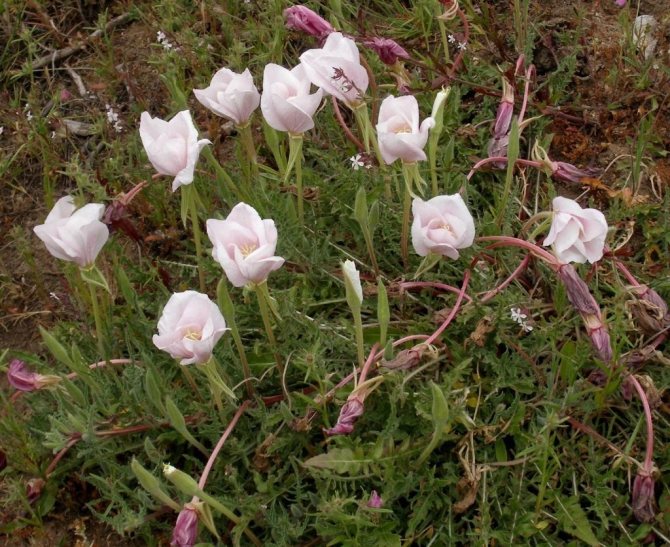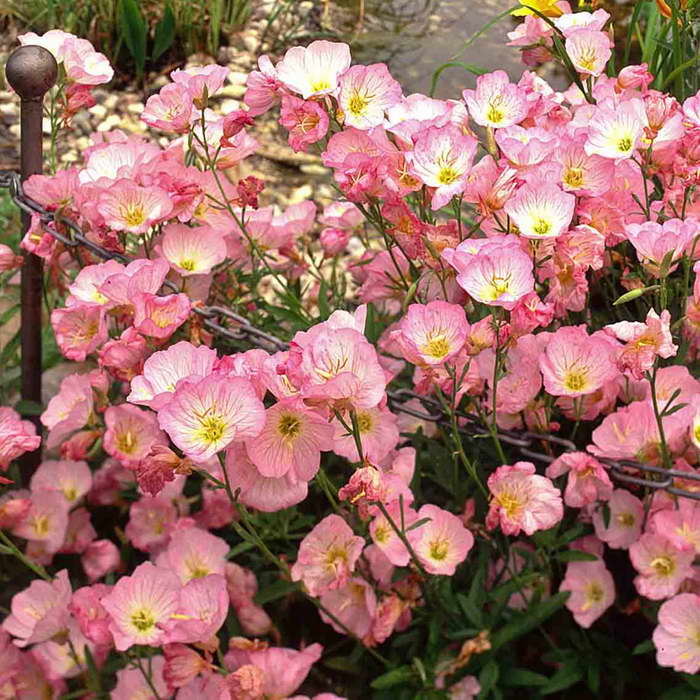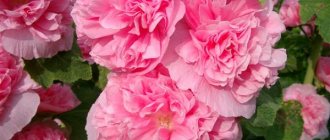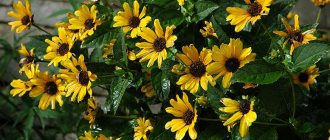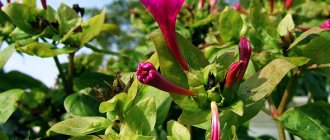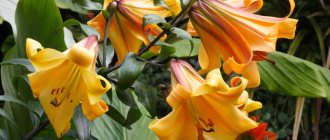Varieties and types of perennial evening primrose
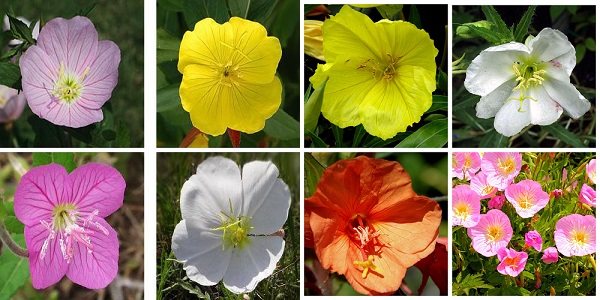
A few facts about the popular plant:
- the homeland of evening primrose is Central America and Mexico;
- thanks to the active travels of residents of different countries, perennial primrose now grows practically on all continents, in zones with a temperate climate;
- family of Cyprus;
- the stem is erect, the average height of the bush ranges from 30 to 200 cm (depending on the variety);
- flowers are multiple, simple, size - from 2.5 to 3 cm. Shades of petals: pleasant yellow (most popular among amateur flower growers), blue, pink, white;
- despite the absence of double buds, evening primrose has a high decorative effect;
- popular names for a perennial ornamental bush: donkey, night candle, evening rose;
- a powerful root system allows the plant to quickly invade new areas. In a short period of time, a spectacular bloom spreads throughout the flower bed;
- a pleasant moment for gardeners and residents of private houses is a long flowering period: from late spring to early autumn. Many species bloom at night, during the day the buds fall off, but in their place new ones quickly grow and it seems: evening primrose never remains without decorative elements;
- the plant has a high decorative effect, often stretching up to 1 m or more;
- many types and varieties have a delicate, rich aroma;
- flowers are grown not only for decorating lawns, flower beds, areas near the curbs, but also for cutting;
- some species have healing properties: a decoction of flowers and green mass is useful for indigestion, a healing tincture from the roots is used to treat wounds and bruised areas. Evening primrose oil is actively used in cosmetology;
- the plant is unpretentious, tolerates well changing weather conditions, drought, pest attacks, rarely gets sick. With timely rejuvenation of the plantings, you can admire the beauty of delicate flowers for many years.
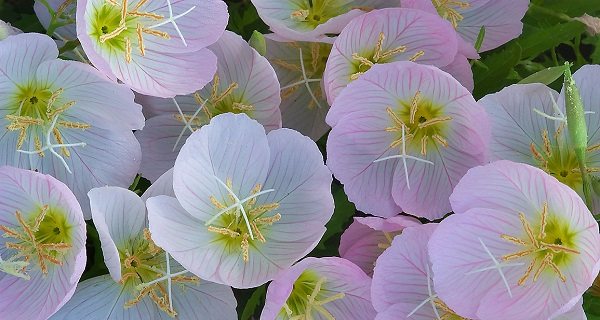

Popular evening primrose varieties for growing in temperate climates:
- Shrub. Small simple flowers, color - "interesting" yellow, "sunny". The height of the bushes is up to one and a half meters.
- Large-flowered. Large yellow buds, characteristic, intense aroma. The height of the plants is about 2 m.
- Missouri. Small flowers with yellow petals are bowl-shaped. The undersized species actively grows, blooms for a long time: from the beginning of summer to the first frost.
- Fragrant. The plant blooms during the daytime. The view is suitable for areas where there is little light: the variety is shade-tolerant.
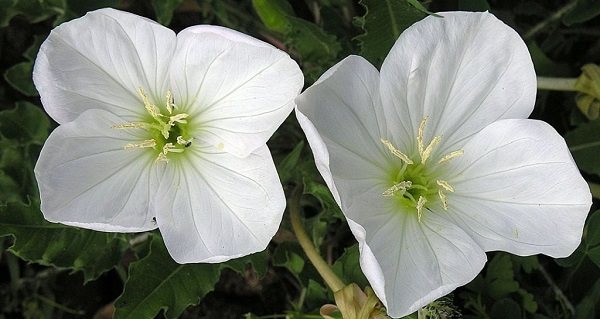

Beneficial features
The perennial donkey has a number of useful properties related to various fields of use.
Medicine
Perennial mallow - planting and care
This plant is used in medicine to create medicines. For this purpose, you can use the seeds and roots of bush evening primrose. You can use the oil made from them. It is considered an effective remedy for eczema, can help with allergic reactions, help blood vessels to increase the tone of the walls, and can normalize blood cholesterol levels.
For women, this drug can improve well-being when critical days come.The oil allows you to care for the skin, has a rejuvenating effect, and can improve the elasticity of the skin.
Important! The use of the product is prohibited for those who suffer from glaucoma.
It is allowed to use crushed plant seeds instead of oil. They are used for the same symptoms. For treatment, take a teaspoon two or three times a day. If it is necessary to engage in the prevention of these diseases, then half a teaspoon, which is taken daily, is enough.
The roots, which are collected from annual plants, have healing power. It is possible to take aerial parts from two-year-olds. The infusions that can be prepared from them are effective in the treatment of kidney stones, diarrhea, cough, asthma. This composition helps to normalize the body's work. It is useful for the stomach, spleen, liver, has a relaxing effect on the heart muscle in the presence of neuralgia.
Attention! The decoction of the roots can be used to cleanse wounds or bruises.
Cooking
The roots contain a large amount of vitamin C. They are rich in insulin, starch. If dug up in early spring, they can be used in salads.
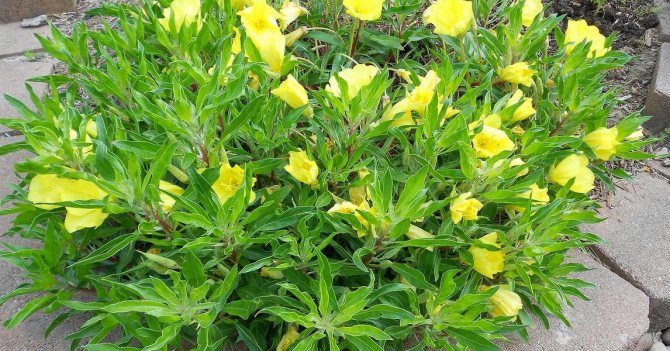

Enotera Missouri
Growing seedlings
A popular method is used by flower growers from different regions. The seeds of the "night candle" are small, it is not very convenient to sow them directly into the ground. They are engaged in seedlings from mid-February.
Soil and capacity
For growing seedlings, both individual containers are suitable, as well as a container with compartments for each seedling. You can take plastic cups for sour cream, yogurt, volume - about 250 ml. Soil with a neutral acidity level, based on turf, peat, sand. The grown seedlings are transplanted into individual pots. High quality peat pots are suitable.
Seedling care
Important aspects of growing a young primrose:
- watering. Spraying of seedlings occurs as the substrate dries up. The soil in the mini-greenhouse should not be allowed to lose acceptable moisture: young shoots take root worse, dry out, and weaken. It is more useful to spray the soil than to add water;
- temperature. The donkey seedlings love moderate heat. It is useful to keep mini greenhouses on a well-lit windowsill or near a window so that the light falls on the plants. The room should be warm enough: about + 22 ° C, then the seedlings grow more actively, but it is not worth keeping a container with seedlings under direct rays for a long time;
- humidity. Seedlings of almost all types of ornamental plants love high humidity. It is not difficult to achieve 75-80% indicators: the mini-greenhouse is covered with glass or foil. For periodic evaporation of the accumulated moisture, the glass is slightly pushed back every two days, the seedlings are aired. The time is gradually increased from 10 minutes to 1–2 hours;
- hardening. A couple of weeks before planting, young shoots are accustomed to natural conditions. The method is similar to airing, but the glass is completely removed at first for 30 minutes, gradually adjusting the time for 8-10 hours. Before planting on the site, hardened primrose seedlings should safely stay the whole night on an unglazed balcony or on the street.
Transplanting
It is important to wait until the seedlings become strong, three or four leaves appear. Optimal terms: third decade of April - early May. Do not rush: return frosts can destroy immature young plants.
Features of planting a plant
Planting evening primrose is most often done using seeds. The prepared seeds can be planted at the very beginning of spring for seedlings in pots and boxes, or after the frost leaves, directly into the ground. However, in this case, flowering will come only next year. Seeds are sown to a depth of 2-3 cm.
The place for evening primrose can be set aside both sunny and shaded.Good soil drainage should be an important factor in site selection. Evening primrose is much easier to tolerate a slight drought, stagnant water.
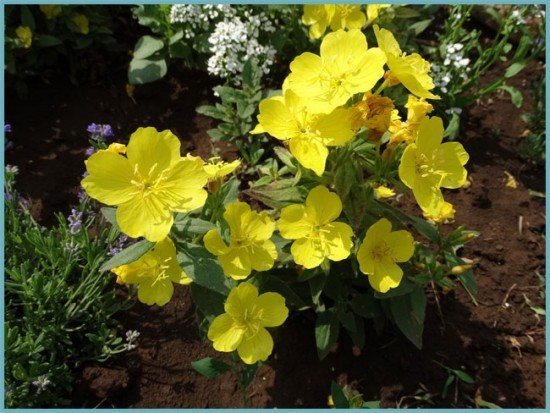

Whichever place you choose to plant evening primrose, provide the plant with good drainage.
Evening primrose is undemanding to soil, but it will feel very good in loamy loosened soil.
In May, seedlings are planted in the ground at a distance of 50 cm from each other. It is at this distance that plants will feel comfortable. After planting, you need to slightly moisten the soil with a watering can.
Seed planting in open ground
The breeding method is less popular than growing a primrose from seedlings: the planting material is small, it is inconvenient to work with it. Without preliminary cultivation of seedlings, seedlings are less robust than with special preparation of sprouts at home. Strong shoots do not always appear, especially when the temperature deviates from the average: too "harsh season" interferes with the development of young evening primrose specimens during growth.
Sowing dates
Planting evening primrose seeds is possible in regions where winters are not very harsh. If you follow the rules, there is a high chance of seeing pink, yellow or blue flowers next year.
It is helpful to soak the seeds in a growth promoter. The drug Kornevin gives a good effect. It is important to plant in advance so that the seedlings get stronger before the onset of frost.
Seat selection
Despite the name "evening rose", "queen of the shade", perennial evening primrose grows well in areas where there is a lot of light. Another positive point - a flower from the fireweed family grows well, blooms in the shade and partial shade. It is no coincidence that many amateur flower growers plant a donkey near high-rise buildings, where the direct rays of the sun often do not fall on the flower beds for half a day.
When choosing a site for planting seeds or transplanting mature plants, it is important to consider the following factors:
- lack of boggy;
- not very acidic, the best option is neutral soil;
- the planting area is not in a lowland where water flows;
- the place should be moderately lit, if there is a shadow, then this factor will not be a hindrance. It is important that the primrose does not grow in very dark areas.
Landing rules
How to proceed:
- first, humus is introduced: per 1 sq. m, about 2.5 kg of natural remedies are enough;
- then they dig up the site, break up the clods, loosen them;
- a couple of hours before planting evening primrose seeds, perennial soil is watered;
- combine small seeds with sand, distribute in the holes.
Diseases and pests of primrose
If you care according to the rules, then the chances that the evening primrose will get sick or be attacked by insect pests is close to zero.
In practice, almost no one creates ideal conditions, so there are fungal diseases or aphid attacks. In the first case, the likely cause is waterlogging. In order to cure the plant, it is necessary to remove the part infected with the fungus.
Important!If aphids attack the evening primrose, then you need to carefully examine the leaves and clean them of pests. After that, it is advisable to wash the leaves with a mild soapy solution.
This plant not only blooms in an original way, but also has a special beauty, and can also help improve health and at the same time is good for food. Of course, modern flower lovers are unlikely to eat such a beautiful specimen, but no one forbids admiring them.
Outdoor care
It is difficult to find the same unpretentious plant as the primrose. Bushes develop well even on not very nutritious soil, if the grower additionally feeds the plantings. It is useful to carry out all the main agrotechnical measures at least in a minimal amount, and then bright yellow buds will appear on the flowerbed or lawn for the whole summer.
Watering
With an average amount of precipitation (the norm for a certain region) and the absence of drought, it is not necessary to overfill the plantings of primrose. Perennial Enotera prefers soil with moderate moisture: 1 sq. M. 1.5 to 2 buckets of liquid are enough. This amount of water is applied three to four times throughout the season, approximately 1 time per month.
On a note! In arid regions, additional watering is required. If the spring and summer turned out to be rainy, then it is necessary to adjust the soil moisture so that the water does not stagnate in the soil.
Top dressing and fertilization
On a note:
- The donkey develops well and pleases the eye with delicate petals even without the introduction of mineral compositions, as well as some types of flowers, which are said to "grow by itself": Gaillardia, mallow.
- Despite the unpretentiousness of the plant, you should not purposefully deprive the donkey of additional feeding: once or twice from the beginning of summer to mid-September it is useful to fertilize the soil with a complex composition.
- For 1 sq. m is enough one and a half tablespoons of a mixture of potassium sulphide with superphosphate.
- A good fertilization option is the introduction of wood ash: a thin layer on the prepared soil or in each hole shortly before planting mature plants or seedlings. The procedure is carried out before planting adult plants or seeds.
Deficiency of phosphorus and potassium leads to a decrease in buds or poor flowering. Excessive feeding, especially with nitrogen fertilizers, increases the volume of green mass, but can lead to the development of diseases, and buds also appear in small quantities.
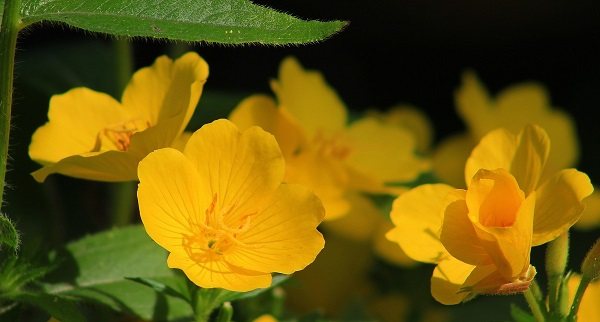

Leaving during flowering
To maintain high decorativeness, it is useful:
- water the land as the soil dries up, especially if there is little rain this season;
- feed with potassium-phosphorus mixtures;
- loosen in time;
- make sure that weeds do not grow;
- remove faded buds from the bushes so that unnecessary elements do not take juices from other parts of the plant.
Important! During the flowering and growing season, it is forbidden to remove shoots in order to maintain the growth rate of the formation of new buds.
Plant rejuvenation
Bushes of all types of "evening rose" grow rapidly, after a few years, adults, old stems remain in the central part of the plantings, and younger shoots at the edges. Every 2 years, experienced flower growers advise to plant a primrose by the method of "dividing the bush". With this approach, you can not only maintain a high decorative effect, but also get a lot of new copies for free to decorate a flower bed, garden or summer cottage.
Soil mulching
A neutral pH soil is suitable for growing evening primrose. The primrose has no special requirements for the composition of the soil, but the substrate must be nutritious and sufficiently loose. It is useful to mix dense soil with sand.
When growing "evening rose" in regions with arid climates, it is advisable to mulch the soil after watering. Peat, straw, sawdust are used as a protective layer. The layer thickness is about 2 cm.
Mulching is useful in preparing the plant for winter. A layer of natural material protects well the underground part of the perennial from freezing.
Protection from pests and diseases
What pests attack the primrose plant? What to do when they appear?
It is useful to take into account information from experienced florists:
- unpretentious plant is ill infrequently, in most cases - against the background of excessive watering. With the development of rot, the affected stems and leaves are removed, fungicides are applied - modern antifungal drugs;
- hawk moth caterpillars often gnaw at the edges of the leaves. With a small number of pests, voracious larvae can be collected, with an invasion of caterpillars, insecticides will be needed for spraying. It is necessary to reprocess the plantings after 5-7 days, taking into account the recommendations of the instructions for a particular drug.
Personal safety rules are mandatory when using insecticides and fungicides.Do not be lazy: protecting the lungs, mucous membranes, eyes, hands is a simple matter, but if the recommendations are violated, severe poisoning is possible. Before spraying and watering the soil using chemicals, wear medical gloves, a respirator, a scarf or cap, and long-sleeved clothing. It is also prohibited to consume drinks and food, smoke while processing plantings.
The striking appearance of perennial garden evening primrose
Evening primrose (Oenothera) unite in one genus, similar in appearance, but different in essence, plants from the number of annuals, biennials and perennials. The most popular representatives of the evening primrose family are precisely perennial species.
Enotera is prone to rapid growth, it captures neighboring territories, creates dense cushion bushes from straight or creeping shoots. The crown is thick and delicate, lush, bright. Lanceolate, oval or feathery evening primrose leaves are densely dotted with shoots, but create only a neutral background for fragrant large flowers. They are collected in pairs or in a cluster of inflorescences, appear almost tirelessly throughout the summer and often almost completely hide the greenery.
Enotera is an evening flower. The plant reveals its charming simple and such pretty "cups" only on the threshold of dusk. Moreover, the flower opens in a few minutes with a charming click, as if by the wave of someone's magic wand. Thanks to this unique property, evening primrose is often called the ideal culture for a meditative garden, inviting you to get away from the hustle and bustle of everyday life and enjoy peace and quiet in the company of the wonders of nature. Enotera is a symbol of the end of the working day and the beginning of rest, a festive and surprisingly spectacular plant.
Beautiful donkey, or beautiful evening primrose (Oenothera speciosa)
Evening primrose has become famous as one of the most spectacular yellow-flowering crops. But in fact, the color palette of perennial evening primrose flowers is wider and includes white, pink, and purple shades.
Reproduction
It is not difficult to breed evening primrose on the site. The main method is dividing the bush. The procedure is carried out in spring or autumn, but not during the period of active vegetation and flowering (summer). Another method is to germinate seeds for seedlings. Often, perennial evening primrose grows during self-sowing of seeds, if the hostess did not collect the ripe and dried planting material from the plants in time.
Transfer
Moving parts of the bush for reproduction is carried out as the perennial primrose grows. Evening primrose can grow in one place for 3-5 years. The root system is actively growing; during transplantation, the roots can be damaged. Avoid moving a mature plant completely: the best option is to divide the bush to rejuvenate the plantings.
The soil in the new place must be fertilized with wood ash. Pits are dug at a distance of at least 50 cm: the supply of space for the growth of a decorative look is important. When moving part of the bush, you need to act carefully, to maximize the preservation of the integrity of the roots.
Comfortable conditions for perennial evening primrose
Evening primrose do not have strict requirements for the lighting regime. They grow equally well in partial shade and in the brightest sun, but strong shading is best avoided. In places where evening primrose will not have enough sunlight, they will release buds, but their flowers will not open by evening. In partial shade, evening primrose flowers sometimes bloom during the day.
Choose the soil from among light and well-drained soils. Pay attention to the acidity: the soil should be neutral, fresh and nutritious.
Planting evening primrose
For successful development for many years and abundant flowering, before planting evening primrose, time should be taken to improve the soil. For each square meter, you need to add 2 tbsp. full of mineral fertilizers (nitrophosphate) and about 3 kg of humus or compost. The soil must be dug to an average depth. The day before planting, the soil is watered abundantly.
Evening primrose, even in massifs, is planted in individual planting holes. After planting, the plants are watered abundantly, in a too hot place, they are shaded.
Watering for evening primrose
Perennial evening primrose plants tolerate drought well. In order to achieve spectacular flowering, it is enough 1-2 times per summer to carry out additional deep watering, using 1.5-2 buckets of water for each square meter of plantings.
Evening primrose
These perennials are not very demanding on soil fertility and with the help of fertilizers you only need to maintain a minimum level of nutrients in the soil. For evening primrose, they are usually limited to one top dressing - 1 tablespoon of potassium sulfate and superphosphate during flowering for each square meter of soil. You can replace mineral fertilizers with wood ash or fertilize with nitrophos at the budding stage.
Pruning evening primrose
Fading stems are not removed from this plant, because they do not affect the duration and effectiveness of flowering. If evening primrose grows in the foreground and the plant is clearly visible, then wilted inflorescences are best removed to preserve the aesthetics of the bushes.
The only pruning of evening primrose is done in the fall, when all aerial parts of the plant are cut to soil levels.
- weeding or mulching for young plants (adult evening primrose plants do not give weeds a chance themselves);
- light loosening of the soil;
- garter shoots to maintain the compactness of tall species.
Autumn care, seed collection and wintering
The seeds are harvested after the elements have ripened. The collected planting material is sorted, the spoiled elements are discarded, they must be dried: they are laid out in one layer on white paper. Prepared seeds are placed in paper bags, stored in a ventilated room, in the absence of heat and dampness.
The donkey tolerates cold well. With proper preparation of the plant, cases of freezing are rare.
Preparation for wintering:
- in the fall, when all the buds have faded, the bushes are cut almost to the root;
- be sure to add a protective layer of natural mulch. Sawdust, peat, fallen leaves are suitable. For the winter, the mulch layer is thicker: about 10 cm;
- in severe frosts, you can cover the wintering primrose with foil or dig out the bushes, transfer them to a room where the temperature does not drop below zero, for example, to a basement or cellar.
The best representatives of perennial evening primrose
In our country, all perennial evening primrose is usually called yellow, although in fact there is no separate species with such a name. Of course, all perennial evening primrose with dense foliage and large goblet flowers that seem to be made of silk are similar, including in terms of cultivation. But each species has its own peculiarities of flowering.
Evening primrose (Oenothera fruticosa) is the most reliable and winter-hardy evening primrose. Semi-shrubs about 1 m high conquer with dark oval leaves that form a dense crown and fragrant five-centimeter flowers of a bright yellow color.
Evening primrose (Oenothera speciosa) is rapidly degenerating, but surprisingly effective. Its oblong leaves, together with flexible shoots, create an openwork pillow, on which cup-shaped white-pink inflorescences bloom en masse, as if covering the bushes with a blanket. It is stored for the winter with digging from the soil or grown in containers.
Enotera Missouri (Oenothera missouriensis) is distinguished by larger flowers, reaching 10 cm in diameter and rising shoots. Golden flowers seem to be curious heads, almost completely hide the leaves, which gives the whole plant originality.
Donkey Missouri, or Enotera Missouri (Oenothera missouriensis)
Stemless evening primrose (Oenothera acaulis) is a strikingly graceful representative of the genus.She forms rosettes of lanceolate leaves, from which, as if slightly embarrassed, bright flowers appear. On cloudy days and with the onset of darkness, funnel-shaped flowers with a light yellow corolla up to 7 cm in diameter shine brightly and catch the eye.
- for blooming spots on the lawn or in landscape groups;
- on flower beds and beds with shading;
- in rockeries and rock gardens;
- for the decoration of borders;
- in the foreground of flower beds and in texture spots;
- to fill bald spots and voids;
- for decorating flower beds or flower beds near the recreation area and terrace;
- in ribbon beds and borders along buildings;
- in the front garden.
The best partners for evening primrose will be bells, lobelia, veronica, astilba, ageratum - plants in which the texture of greenery and the type of flowering will be contrasting.
Donkey stemless, or Enotera stemless (Oenothera acaulis)
Perennial evening primrose in landscape design
Bushes with bright yellow simple flowers look just as exquisite as more capricious outdoor plants. The donkey is used to decorate flower beds (foreground), curbs, lawns, plantings next to the fence.
An interesting combination of ornamental plants is obtained by placing flowers with lilac, red, white petals nearby. Evening primrose looks great next to bells, lavatera, lobelia. It is important to consider what kind of primrose grows in the flowerbed so that such spectacular flowers as petunias do not hide behind tall bushes.
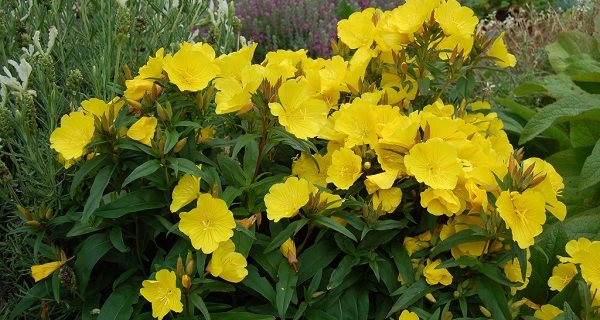

A beautiful and unpretentious plant - a "night candle" with a bright yellow light, is suitable for decorating a flower bed near a house, creating borders and spectacular mono-plantings in the garden. Perennial evening primrose is successfully grown in different regions. An interesting decor option is obtained by combining the primrose with other beautifully flowering plants.
Do you want to know more useful information about the cultivation of Evening Primrose on the site? Watch the following video:
The nuances of planting and caring for evening primrose, Missouri, pink, white
Different types of primrose require a special approach to cultivation. Thus, white evening primrose is subject to rapid degeneration and has a very low threshold of frost resistance. It is recommended to grow it as an annual. Fumbling with seedlings is worth it, because the flowering bushes not only smell pleasantly, but also create the impression of a flock of night barrels with fluttering wings. In the south of Russia, the flower hibernates with shelter.
A beautiful or pink variety is often grown as a flowerpot crop, bringing a delicate rhizome for the winter to a cool basement.
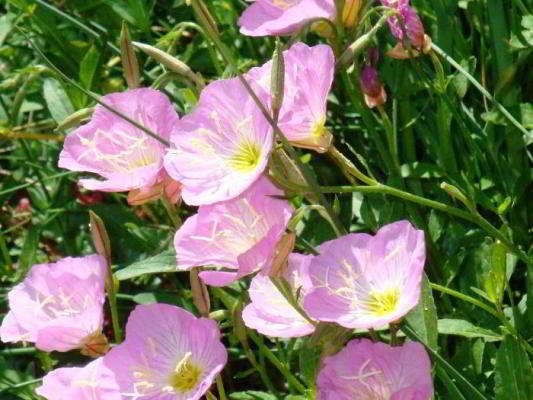

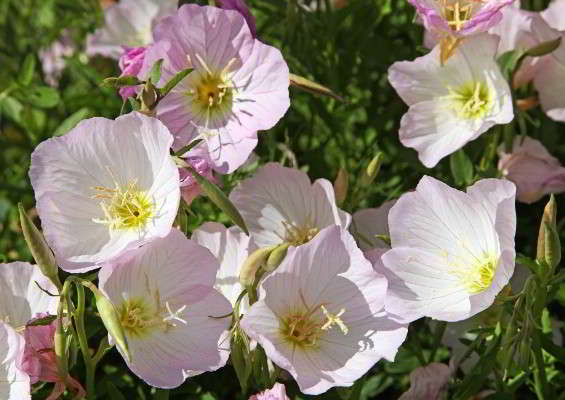

Missouri and shrub (yellow) evening primrose are cultivated by both seedling and non-seedling methods. Both species are considered resistant to degeneration and frost. To protect the rhizomes from freezing after autumn pruning, pour a layer of peat or sawdust 15-20 cm high. Cover the young bushes with spruce branches.
Combination with other plants
When growing evening primrose with other plants, it is required to take into account the characteristics of the plant - the root system of the flower is strong and grows rapidly.
This circumstance can lead to certain inconveniences on the part of other plants.
It is recommended to limit the freedom of evening primrose by digging slate or metal plates around its plantings, which will reduce the space for the growth of the root system.
The following plants are the best neighbors for evening primrose:
- Ageratum;
- Veronica;
- Astilbe;
- Lobelia;
- Bell.
These plants are able to set off the beauty of evening primrose and do not experience inconvenience when growing next to it.
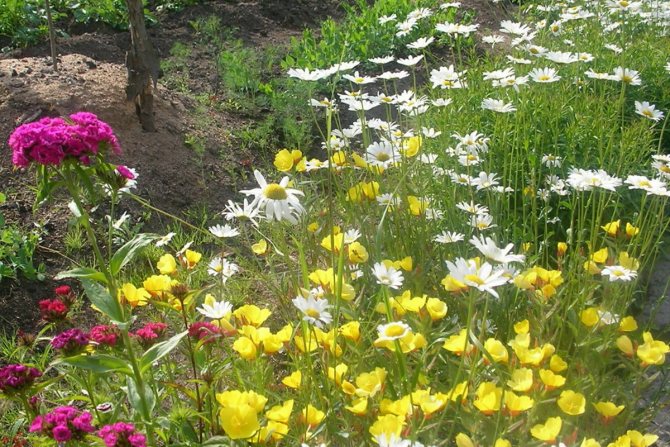

Description of colors
One of the yellow evening primrose varieties is called Missouri. This plant is short, perennial, with flowering, which occurs from June until the first frost, it exudes a pleasant aroma, citrus notes are guessed in it.Missouri evening primrose flowers are medium, resemble glossy cups, they can be up to four centimeters in diameter, collected in graceful inflorescences with a diameter of about ten centimeters. Gardeners loved this variety for its decorative effect. Bushes of yellow evening primrose grow well, they can decorate the entire territory with their lush and abundant flowering.
Seedling method
To achieve the flowering of a night candle (Missouri evening primrose), you need to prepare seedlings. Seeds are planted in peat cups or plastic filled with fertile soil (with good drainage) at the end of February, shoots will appear in the interval from a week to four. Maintain the air temperature at about 20 degrees, water if necessary. In May, when the seedlings are strong, there will be no threat of frost, they can be planted in the garden. How to do it correctly, read the content below.
Loosening the soil
The main care for evening primrose lies precisely in the frequent loosening. This will allow the soil to be saturated with oxygen and get rid of excessive moisture. In addition, it is necessary to remove weeds, they are able to reduce the growth of evening primrose, although she herself perfectly clogs all around the growing grasses and crops. That is why it is not recommended to plant it with other ornamental plants.
Missouri evening primrose must be completely cut at the very root in the fall. Covering material is needed to protect the roots in winter; spruce paws will also serve well for this.
What is it like
Enotera unites in itself externally similar, but differing in their essence, plants - annuals, perennials and biennials.
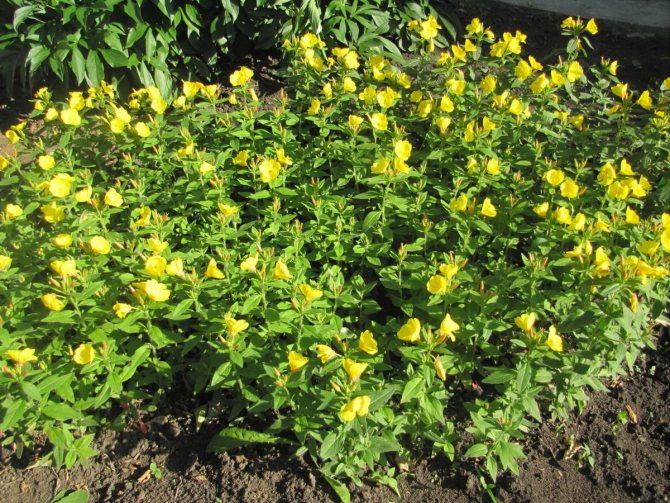

The most popular among gardeners are perennial evening primrose varieties, which tend to grow rapidly.
The plant creates dense bushes, consisting of creeping or straight shoots. The crown is thickened.
The leaf plates are oval, lanceolate or feathery, densely covering the stems, but are only a background for bright and large inflorescences.
The inflorescences are collected in pairs or brushes, they are formed throughout the summer season - evening primrose in fact blooms throughout the warm period without interruption.
Inflorescences open in the evening hours - on the eve of dusk.
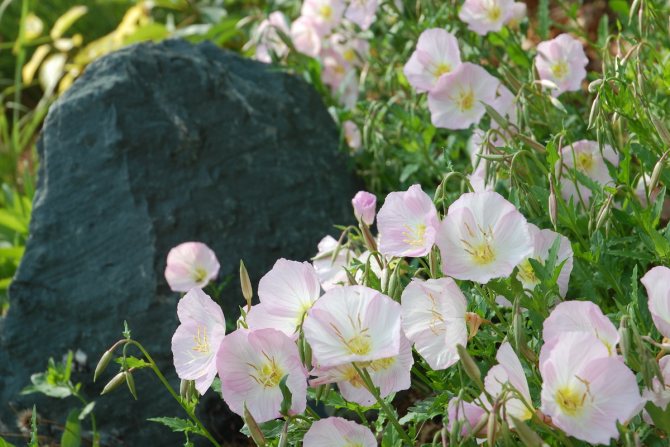

The plant can produce inflorescences of the following colors:
- white;
- yellow;
- purple;
- pinkish.
But it is generally believed that evening primrose is one of the brightest yellow-flowering plants.
Interesting!
Enotera is considered a symbol of the end of the working day and marks the beginning of relaxation.
Use in traditional medicine
The plant is more often used for decorative purposes, less for medicinal purposes. Not everyone knows about the beneficial properties of evening primrose. For the preparation of healing recipes, tubers are taken, which are harvested in the first months of flowering (the optimal time is June and July).
They contain starch, flavonoids, tannins, glycosides, sugar, sitosterol, and a large amount of mucus. Decoctions and infusions are used to treat digestive disorders, women's diseases, toothache, inflammation of the urinary tract, and pustular wounds.
Procurement of raw materials occurs in the following sequence:
- first, the tubers are dug up;
- the aboveground part is removed;
- the bark is cut off;
- the peeled tuber is placed in boiling water (to avoid further germination);
- then drying is carried out in air, in attics, in a dryer (t <55 ° C).
Sowing seeds
In this way, it is best to plant a perennial. Enotera Missouri belongs to just such a species, therefore it is ideal. The seeds of the plant are very small, the first thing to do is to mix them with a small amount of sand and plant them in a prepared area to a depth of no more than five millimeters.
In the first year, do not expect flowering, only stalks with leaves will appear. The Missouri evening primrose will begin to bloom from the second year of life.
It is possible to plant seeds in open ground only when the earth warms up to +15 degrees, there will be no danger of frost. When shoots appear and get a little stronger, thinning will need to be done.
The chemical composition of the primrose
The leaves of the plant contain tannins (up to 11%) and macro- and microelements (calcium, potassium, sodium, magnesium, zinc, iron, selenium). The seeds contain up to 25% fatty oil (a mixture of unsaturated fatty acids and triglycerides). The roots of the primrose are rich in protein, minerals, resins, sterols and starch. Evening primrose oil contains vitamin E and gamma-linoleic acid (Omega-6).
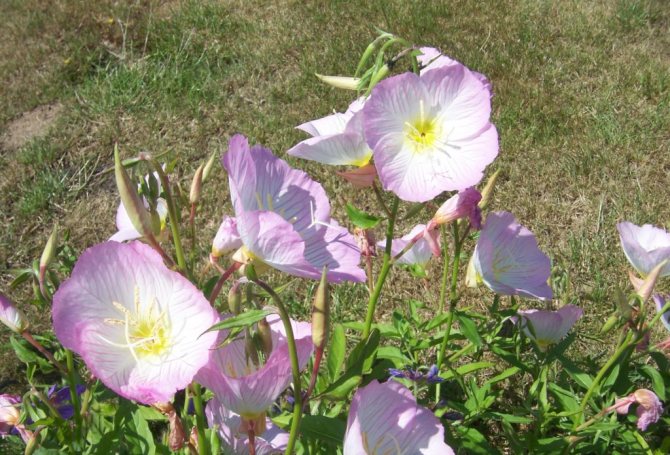

The roots of the primrose are rich in protein and minerals
Popular evening primrose varieties
There are more than 100 species of perennial, annual, tall and short evening primrose.
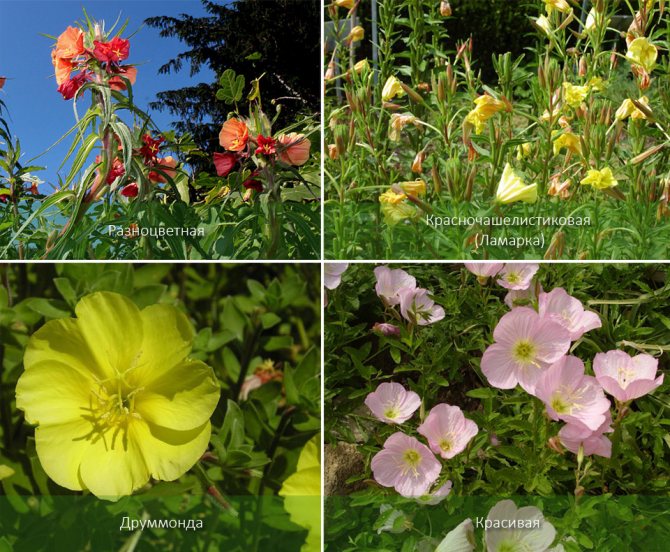

In central Russia, two-year-old species are grown:
| View | Description | Leaves | Flowers |
| Drummond | It grows up to 0.8 m. The stem is thickened, strongly branching. | Opposite, pointed towards the top, long, lanceolate, dark green. | They consist of four yellow petals, the size of which is 70 mm. |
| Multicolored | Height - 1.2 m. In gardening, the Sunset Boulevard variety of this type is quite often used (its height is 0.4 m). | In the beginning they are oblong, and towards the end they become lanceolate. The leaf plates are arranged alternately. | Painted red. |
| Evening two-year (night candle) | Reaches 1.2 m. Shoots are erect, covered from above with a huge number of small hairs. The Vechernyaya Zarya variety is very popular. His height is 100 cm. | Sparsely toothed, whole, about 20 cm long. | The size across is 50 mm. Their color is lemon, and flowers open either when it is cloudy or in the evening. Evening dawn - yellow, with a red tint. |
| Beautiful | The height of this bush is almost half a meter. | Oblong, with sparse teeth along the edge. | The flower is cupped, about 50 cm in diameter, the color is either pure white or with a pinkish tinge. |
| Red chalice (Lamarck) | No one knows exactly how this biennial came into existence. There is an assumption that he was born in the Old World due to a mutation. This is an upright bush, about 100 cm high. | Oval, smooth, greenish in color. | The inflorescences are yellowish flowers. |
In middle latitudes, yellow perennial winter-hardy evening primrose species are used:
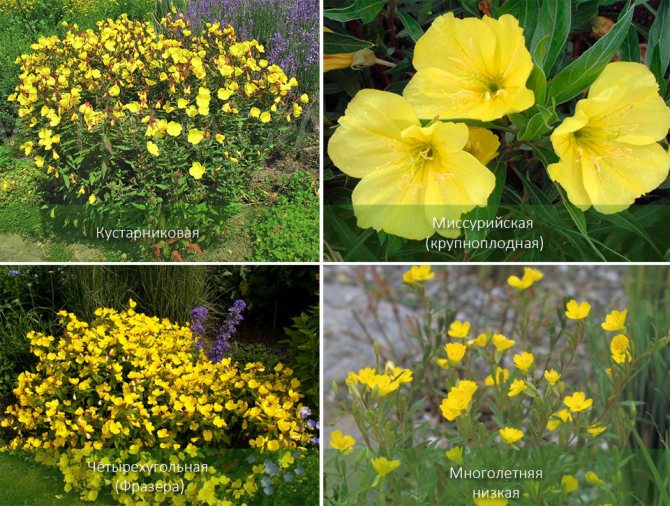

| View | Description | Leaves | Flowers |
| Missouri (large-fruited) | Homeland - the south of North America in 1811. Grows up to 0.4 m. Rarely used. | Dense, oval, narrow, lanceolate. | Golden solitary, almost lying on the ground, usually 100 cm in diameter. Blooms from July until frost. Has a citrus aroma. |
| Perennial low Pernis (pumila) | Distribution area North America. Its height is about 25 cm. | Narrow-lanceolate leaves are about 15 mm wide. | Yellow, spikelets and usually up to 15 mm in diameter. |
| Quadrangular (Frazera) | This plant, like the previous one, appeared in the east of North America. Height - 0.7 m. | Oval, green-blue, and turn pale red in autumn. | Shields are composed of yellowish flowers. |
| Shrub | This species came to us from the east coast. Reaches 1.2 meters. | Oval, slightly elongated, dark green. | Yellow, fragrant, 50 mm across. |
Origin
The plant of the evening primrose yellow candle comes from America. It is characterized by the presence of creeping stems that grow no more than 90 cm in height. Shoots die off by the onset of winter cold, but in spring they grow back. Enotera is a perennial plant and can live for about 10 years under favorable conditions.
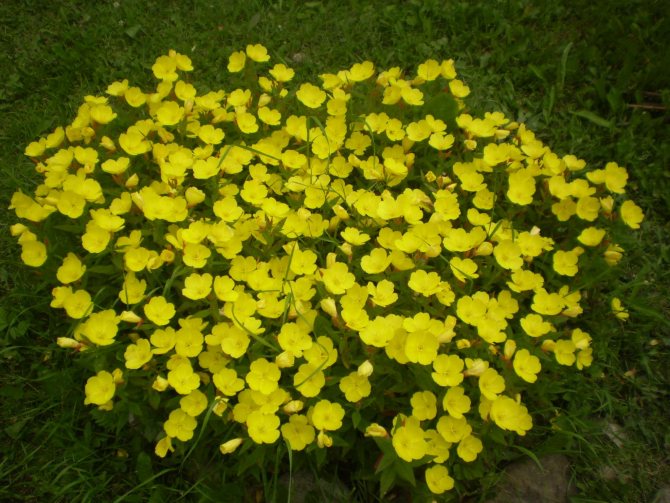

Evening evening candle
It begins to bloom in June, you can enjoy flowers before the onset of autumn frosts.
Interesting. Each next year, the plant blooms even more abundantly and more intensely.
In natural conditions, evening primrose blooms like a weed on the banks of the river, at the edge of the forest.
Preparation for wintering
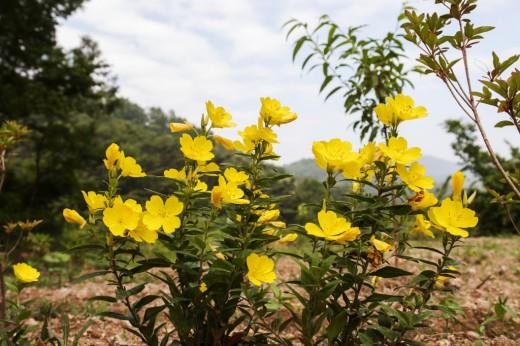

Enotera is a fairly frost-resistant plant and does not need a strong shelter for the winter. After all the above ground parts have been removed, it is enough to mulch the soil with a layer up to 5 cm high. Compost or peat can be used as protective materials. In the first year after planting, it is better to cover young evening primrose with spruce branches or a dry leaf.
Photo gallery
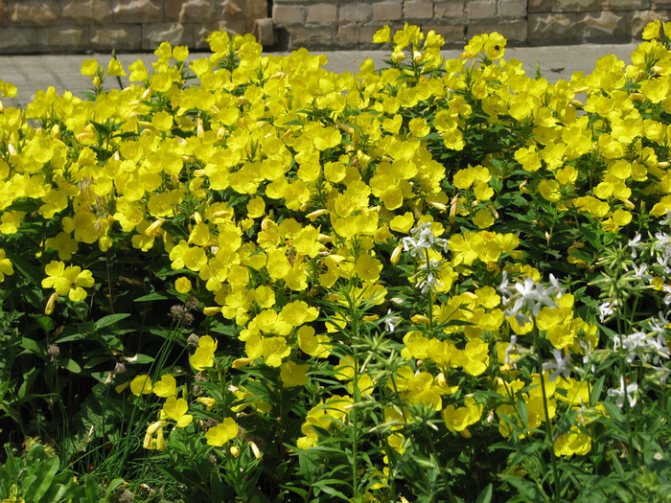

Photo 1. Lush evening primrose bloom
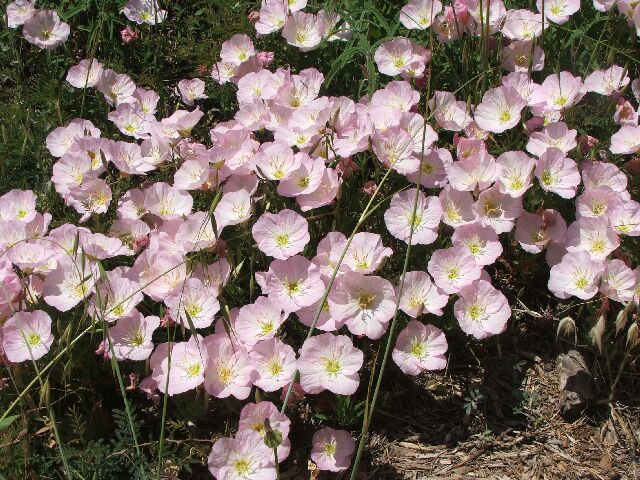

Photo 2. Pink evening primrose flowers
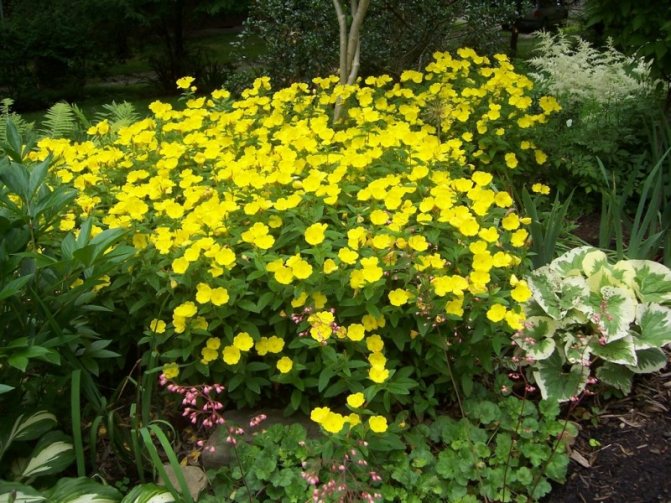

Photo 3. Evening primrose in combination with other plants
Watering
Photos of evening primrose flowers are striking in their beauty. The plant has bright and eye-catching buds. And it seems that such delicate flowers require careful care.
In fact, evening primrose is unpretentious. For example, it is considered drought-resistant and practically does not need watering. Only young plants need to be watered regularly, while an adult primrose can be content with seasonal rainfall. In hot dry summers, evening primrose is watered 2-3 times per season, but abundantly - 15-20 liters per square meter.
Dividing the bush
This is the easiest way to propagate and plant Missouri evening primrose flowers on your property. If your friends have these plants, then ask them for a bush. It is quite simple to divide the flower, the plant must be dug up in spring or autumn along with the root and a clod of earth, and then put into water for a safer separation - this way the root system will be less damaged. It is possible to do without digging out the bush, many give side shoots that can be carefully removed from the soil without damaging the main plant. Enotera Missouri tolerates transplanting well even during flowering.
The use of evening primrose at their summer cottage
Evening primrose bushes can organically complement any composition. They are good in group plantings on mixborders, and undersized species are very often used in rock gardens. Annuals can be grown in pots and hanging planters that can be used to decorate any corner of the yard.
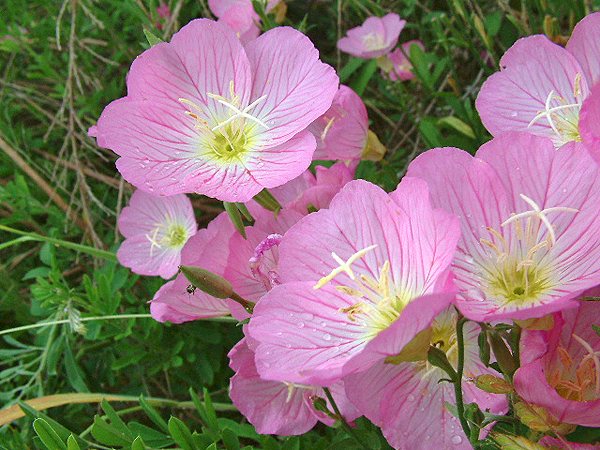

It is advisable to plant tall varieties in the background of a flower garden. In this case, they create a good background for the flowers growing in front of them. As for the composition of combinations, evening primrose goes well with any flowering crops.

